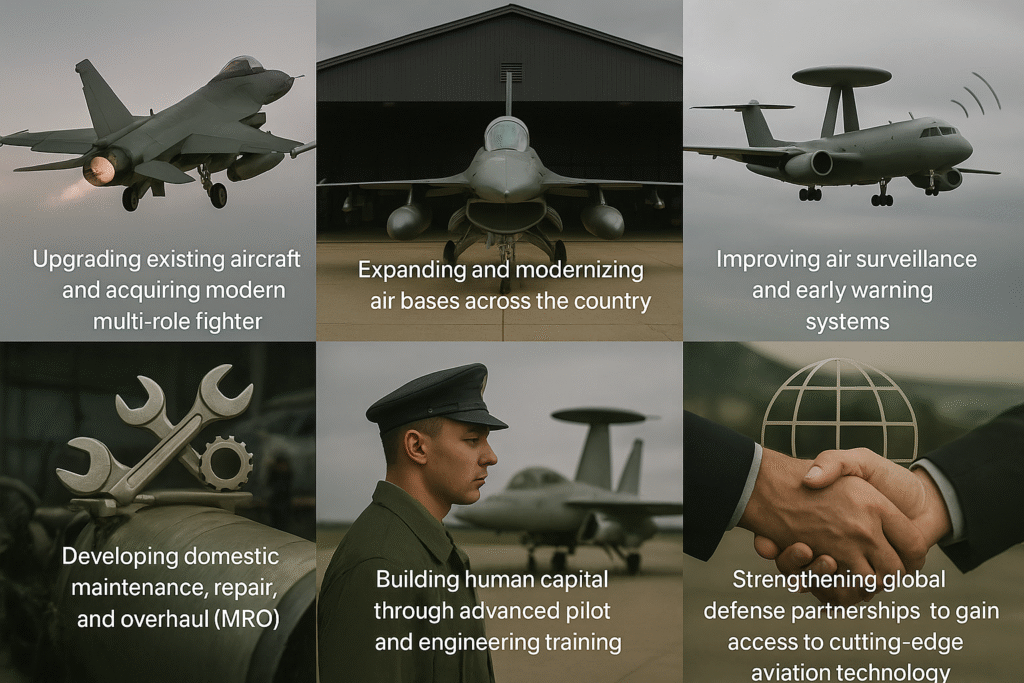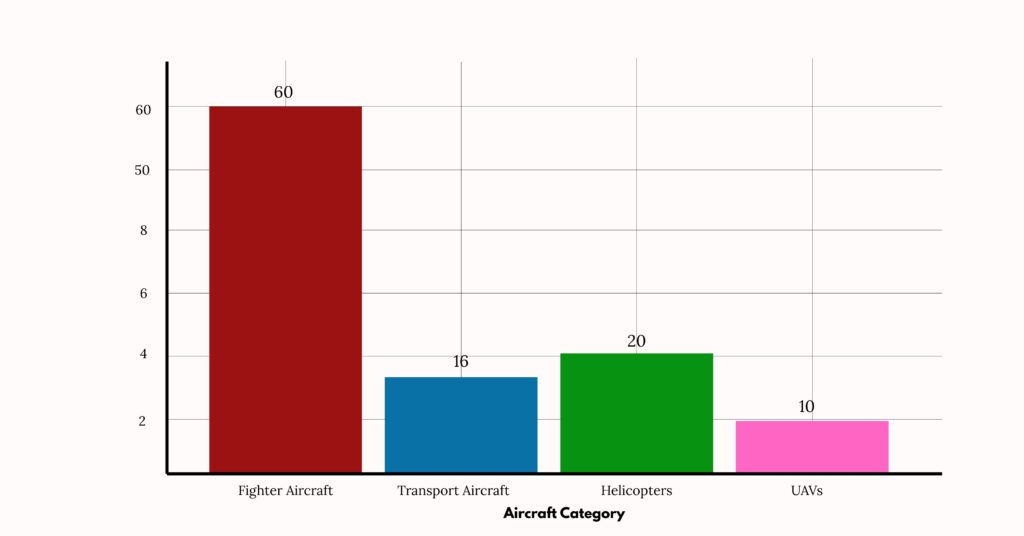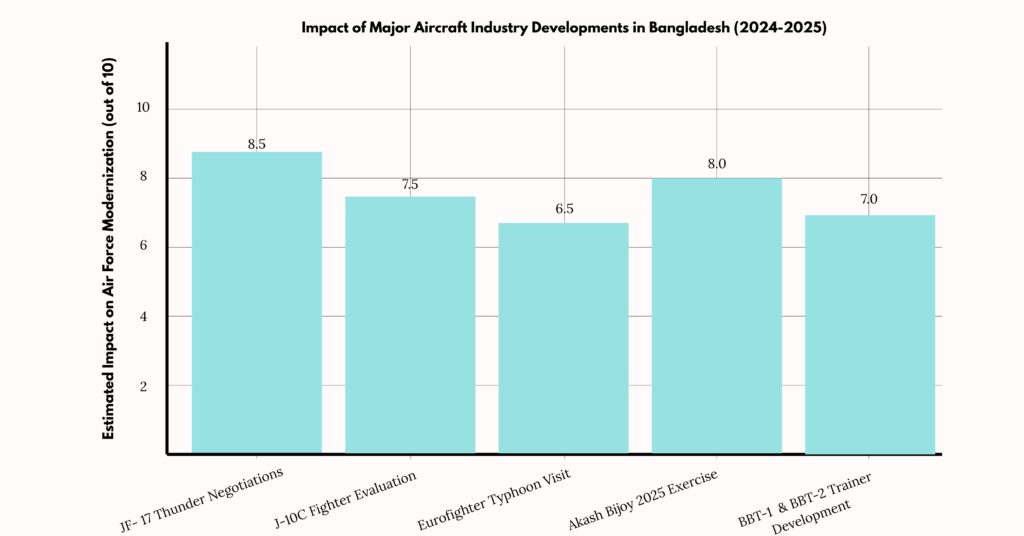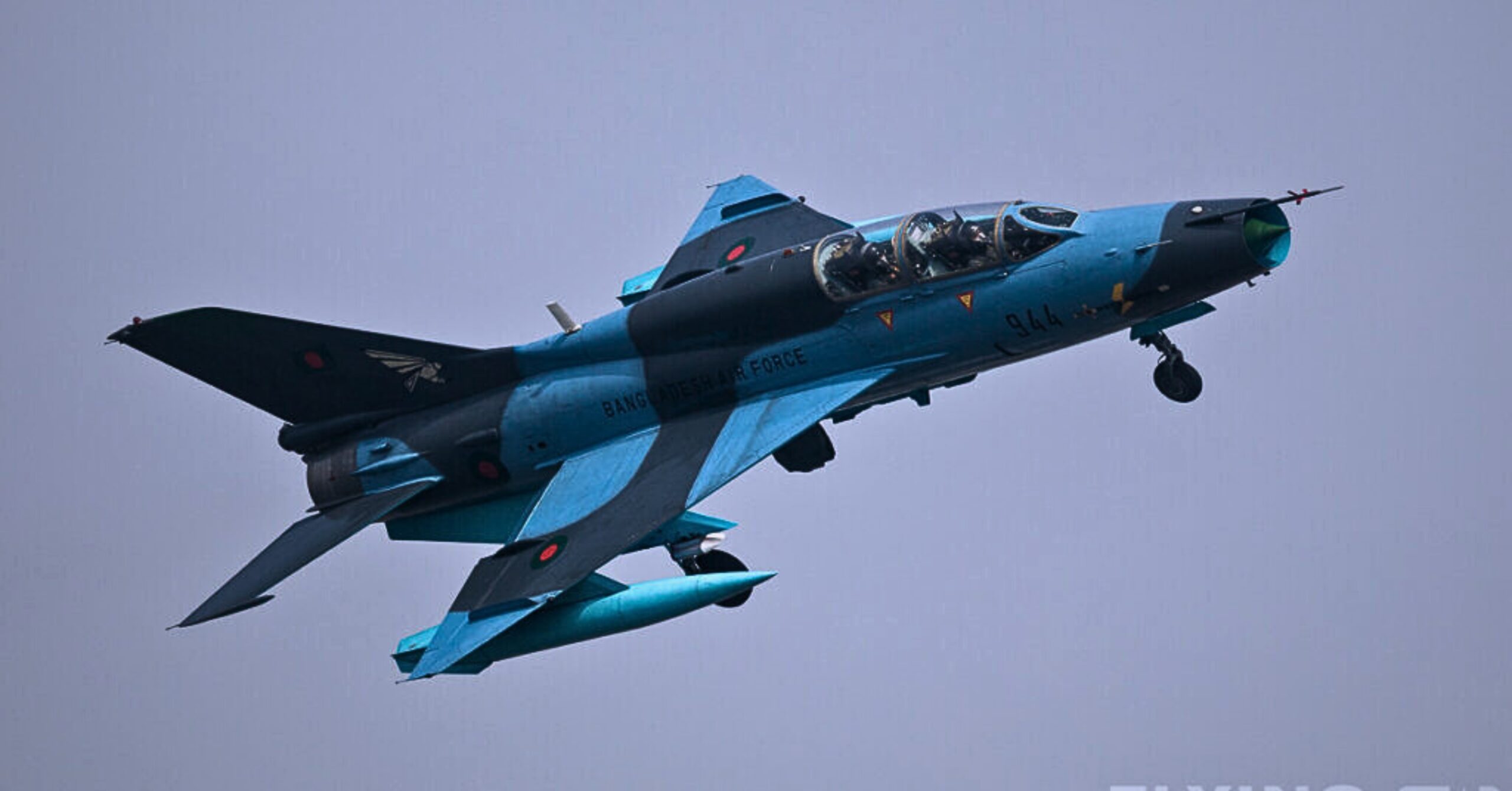Close your eyes and imagine a modern fighter jet roaring in the skies of Bangladesh. This image is not a fantasy. Now it is becoming a reality. There was a time a few years ago when Bangladesh’s fighter fleet consisted of Russian MiGs and old Chinese F-16 fighter jets. But times have changed. The government has changed. And the perspective has changed.
Now, following the strategy of modern fighter aircraft, Bangladesh is about to introduce one of the world’s most powerful fourth-generation fighter jets, the Chengu J-10, also known as the Victorious Dragon. This is the fighter jet that was once only heard of in the skies of Pakistan and Egypt. Now that sound can be heard in our Dhaka sky as well.
1. Introduction
Aircraft capabilities form the backbone of a nation’s defense posture, emergency response systems, and technological advancement. For a strategically positioned country like Bangladesh, surrounded by regional giants and exposed to climate vulnerabilities, the strength and modernization of its aviation sector hold significant importance. In recent years, escalating political uncertainties, particularly in South Asia and the Indo-Pacific, have further underlined the urgency of building a robust and self-reliant aircraft ecosystem.

Bangladesh’s interior government has prioritized aerospace development as a core part of its national security and technological ambitions. While significant progress has been made, the journey is far from complete. Bangladesh still faces gaps in terms of advanced technology, local manufacturing capacity, and research and development (R&D) ecosystems. Yet, the momentum is building.
2. Historical Background of Bangladesh’s Aircraft Industry
2.1 Origins and Early Development
The journey of Bangladesh’s aircraft industry is deeply rooted in the nation’s birth. During the Liberation War in 1971, the Bangladesh Air Force (BAF) was born out of necessity, initially operating with only a handful of aircraft, many of which were donated or captured from adversaries. Despite its modest start, these early efforts laid the foundation for what would become a critical arm of the country’s defense system.
In the decades following independence, especially throughout the 1980s and 1990s, the BAF began to diversify its fleet. It acquired aircraft such as the Chinese F-7 series and the Russian MiG-29s, mainly used for air interception, patrolling, and limited strike missions. However, the lack of local manufacturing, advanced technology, and comprehensive pilot training systems meant that Bangladesh remained reliant on foreign suppliers for both hardware and technical support.
2.2 The Forces Goal 2030 Initiative
A significant turning point came in 2009 with the introduction of the “Forces Goal 2030”—a long-term strategic modernization plan designed to overhaul the capabilities of Bangladesh’s Army, Navy, and Air Force. For the Bangladesh Air Force, this initiative marked the beginning of a more structured and ambitious journey.
Key pillars of the program include:

- Upgrading existing aircraft and acquiring modern multi-role fighters
- Expanding and modernizing air bases across the country
- Improving air surveillance and early warning systems
- Developing domestic maintenance, repair, and overhaul (MRO) capabilities
- Building human capital through advanced pilot and engineering training
- Strengthening global defense partnerships to gain access to cutting-edge aviation technology
Forces Goal 2030 has already led to the establishment of new air wings, acquisition of next-generation aircraft, and the creation of specialized training centers. It has also spurred early conversations around building a homegrown aviation industry—including local manufacturing, UAV (drone) development, and enhanced R&D. This chapter in Bangladesh’s defense story demonstrates a shift from dependency to capability-building, from being a buyer of second-hand aircraft to aspiring to be a regional hub for air power innovation and indigenous defense technology.
3. Current Aircraft Capabilities (2024–2025)
Bangladesh’s Air Force capabilities today reflect a transitional phase characterized by an aging combat fleet, operational transport assets, emerging UAV technology, and ongoing modernization efforts under the Forces Goal 2030 program. While the Air Force maintains a functional balance between offense, defense, and logistics, significant gaps remain in terms of technological sophistication, operational readiness, and fleet diversity.
3.1 Fighter Aircraft: Struggling to Meet Modern Air Defense Needs
The backbone of Bangladesh’s fighter strength lies in three main platforms, each with unique strengths and inherent limitations:
- Chengdu F-7BG/MB (China): With approximately 36 units, the F-7 serves primarily as an interceptor, tasked with quick reaction alert (QRA) missions and airspace defense. However, the airframe is a legacy design dating back to the 1950s MiG-21, and despite upgrades, the F-7’s limited radar range, absence of advanced beyond-visual-range (BVR) missile integration, and minimal avionics modernization restrict its operational effectiveness in contested airspace. This leaves the force vulnerable to enemy aircraft equipped with modern radar-guided missiles and electronic warfare systems.
- MiG-29UB (Russia): The MiG-29 multirole fighters provide enhanced agility and a multirole strike capability beyond interception. The force operates roughly 8 MiG-29UBs, used for pilot training and secondary combat missions. Nevertheless, maintenance challenges persist due to the scarcity of spare parts and the need for frequent upgrades to avionics, radar, and weapons systems. Without modernization, these jets risk becoming non-operational in high-intensity conflicts.
- Yakovlev Yak-130 (Russia): Serving as an advanced jet trainer and light combat aircraft, the Yak-130 fills a dual role of pilot development and limited ground attack missions. Approximately 16 units support the training pipeline and close air support in low-threat environments. However, its light combat payload and short range limit frontline applicability. The platform’s primary value lies in its cost-effectiveness and adaptability to training Bangladesh’s next generation of pilots.
Overall, Bangladesh’s fighter fleet currently lacks 4th or 5th generation stealth and multirole combat aircraft, which poses strategic vulnerabilities, especially given regional air power developments. This necessitates urgent acquisition of modern fighters and investments in avionics upgrades, electronic warfare, and missile technology to ensure credible air defense and deterrence.
3.2 Transport Aircraft: Supporting Defense and Humanitarian Operations
Transport aircraft form the operational backbone of Bangladesh’s air logistics, disaster response, and peacekeeping missions:
- C-130J Super Hercules (UK/USA): The C-130J is the most capable heavy transport aircraft in the fleet, with excellent payload capacity (up to 20 tons), extended range, and versatile operational flexibility. Its capabilities support strategic airlift of troops, heavy equipment, and humanitarian aid to remote and disaster-affected areas. The aircraft has proven critical in UN peacekeeping operations and during natural disasters such as floods and cyclones.
- Antonov An-32 (Soviet Union): The An-32 provides medium-lift transport capabilities essential for shorter-range logistical missions within Bangladesh and regional deployments. While robust, the aging An-32s require increased maintenance and face challenges related to fuel efficiency and avionics modernization. Plans for gradual replacement or upgrades are under consideration.
- CN-235 (Indonesia): The CN-235 series serves as a light tactical transport and maritime patrol aircraft. Its ability to operate from short and unpaved runways allows flexible deployment for border surveillance, coastal patrols, and quick troop insertions. Its role is growing as Bangladesh expands maritime security and surveillance of its Exclusive Economic Zone (EEZ).
Transport aircraft also support civil-military coordination during emergencies, enabling rapid deployment of relief materials and personnel. However, limited fleet size and aging airframes underscore the need for additional acquisitions or leasing of modern transports.

3.3 Helicopters: Multifaceted Assets for Tactical and VIP Missions
Helicopter capabilities complement fixed-wing aircraft by offering versatility in troop movement, logistics, and reconnaissance:
- Mi-171Sh (Russia): These heavy-lift utility helicopters are workhorses for troop transport, cargo delivery, medical evacuation, and Search and Rescue (SAR) missions. Their high payload capacity and ruggedness make them indispensable during flood relief operations and counterinsurgency tasks. Recent upgrades focus on avionics and defensive aids to improve survivability in hostile environments.
- Bell 212/412 (USA): Mainly tasked with VIP transport, liaison missions, and light logistics, these helicopters are reliable but limited in combat capacity. Their relatively small size and maneuverability allow rapid insertion and extraction but restrict their use in high-intensity conflict zones.
- AW139 (Italy): Recently inducted, the AW139 expands Bangladesh’s capabilities in maritime patrol, coastal security, and elite transport. Equipped with modern avionics, surveillance sensors, and multi-mission adaptability, these helicopters enhance BAF’s ability to monitor offshore assets and conduct rapid response missions.
Helicopters play a vital role in supporting ground forces, coastal defense, and disaster response. However, ongoing fleet modernization and pilot training programs are necessary to optimize operational readiness.
3.4 UAVs and Surveillance Systems: Emerging Force in Intelligence and Precision Strike
Unmanned Aerial Vehicles (UAVs) represent a fast-growing segment of Bangladesh’s aerial capabilities:
- Wing Loong II (China): Though official confirmation is pending, reports suggest Bangladesh is acquiring or exploring these armed drones capable of long-endurance reconnaissance and precision strikes. The Wing Loong II can carry air-to-ground missiles and laser-guided bombs, providing stand-off attack capabilities crucial for counterterrorism and border security operations.
- Indigenous ISR Drones: Bangladesh has invested in developing local drone technology aimed at border surveillance, anti-smuggling operations, and disaster management. These smaller, cost-effective UAVs enhance real-time intelligence gathering, situational awareness, and rapid communication with command centers.
The UAV program remains nascent but aligns with global military trends emphasizing network-centric warfare, persistent surveillance, and cost-efficient precision targeting. Expanding drone capabilities will be critical for Bangladesh to maintain effective aerial domain awareness and supplement limited fighter and helicopter assets.
Read more: 2024–2025 Fintech Outlook: Exploring Landscape & Opportunities in Bangladesh
4. Major Developments in 2024–2025
The period of 2024–2025 has been pivotal for Bangladesh’s aircraft industry, marked by strategic procurement talks, significant training exercises, and early strides toward domestic manufacturing. These developments signal a clear intention to modernize the Bangladesh Air Force (BAF), improve operational readiness, and build foundational aerospace capabilities within the country.
4.1 JF-17 Thunder Negotiations: Modernizing the Fighter Fleet
In 2025, Bangladesh formally initiated advanced negotiations with Pakistan Aeronautical Complex (PAC) and China’s Chengdu Aircraft Corporation for the acquisition of 24 to 32 JF-17 Block III fighter jets. The JF-17 Thunder program, a joint Pakistan-China effort, has matured significantly since its initial versions. The Block III variant represents the latest technological iteration, incorporating:
- Active Electronically Scanned Array (AESA) Radar: This radar type enables simultaneous tracking of multiple targets with greater accuracy and resistance to jamming, an essential feature for modern air combat.
- Beyond Visual Range (BVR) Missile Capability: Integration with PL-15 long-range air-to-air missiles greatly enhances the BAF’s engagement envelope, allowing pilots to strike adversaries before visual contact.
- Advanced Electronic Warfare and Sensor Fusion: Block III integrates improved avionics that consolidate inputs from radar, infrared search and track (IRST), and electronic support measures (ESM), enhancing pilot situational awareness.
- Reduced Radar Cross Section: Modifications reduce detectability by enemy radar, improving survivability in contested airspace.
This procurement is a key replacement for the aging Chengdu F-7 fleet, which, based on 1960s technology, has limited avionics and is increasingly obsolete in modern warfare. The JF-17’s competitive unit cost (significantly lower than Western 4th or 4.5 generation fighters) makes it a practical choice for Bangladesh’s defense budget, providing a balance of capability and affordability.
4.2 Interest in Chengdu J-10C: Exploring Advanced Multirole Options
Beyond the JF-17, Bangladesh is carefully evaluating China’s offer of 16 Chengdu J-10C jets, considered a leap forward in technology. The J-10C is a 4.5-generation fighter boasting:
- Stealth-enhanced airframe features.
- Advanced avionics and sensor fusion.
- Superior multirole versatility including air superiority, ground strike, and electronic warfare.
The J-10C would significantly boost Bangladesh’s air combat capabilities, allowing it to operate effectively against modern threats in the South Asian region. However, the high procurement and lifecycle costs require thorough budgetary and operational assessment. As of mid-2025, this proposal remains under close review, weighing long-term strategic value against financial constraints.

4.3 Eurofighter Typhoon Evaluation: Assessing Top-Tier European Technology
In April–May 2025, the Chief of the Bangladesh Air Force conducted a high-level visit to Italy to inspect the Eurofighter Typhoon program, widely regarded as one of the world’s most capable 4.5-generation multirole fighters. The Eurofighter boasts:
- Supercruise Capability: Ability to sustain supersonic speeds without afterburners, reducing fuel consumption during combat.
- Advanced AESA Radar (Captor-E) with enhanced electronic attack and electronic support capabilities.
- Highly Agile Airframe with thrust vectoring (in latest variants) and digital flight controls.
- Multirole Flexibility supporting air superiority, ground strike, reconnaissance, and electronic warfare.
The visit aimed to assess the Typhoon’s performance, logistical requirements, maintenance ecosystem, and lifecycle costs. While operationally outstanding, the Eurofighter’s acquisition and sustainment costs are significantly higher than those of Asian-origin aircraft like the JF-17 or J-10C, possibly straining Bangladesh’s defense budget.
4.4 Akash Bijoy 2025 Exercise: Enhancing Operational Readiness
April 2025 saw the execution of Exercise Akash Bijoy 2025, one of the largest and most complex air drills in Bangladesh Air Force history. This exercise simulated realistic wartime scenarios focusing on:
- Combat Air Patrol (CAP): Protecting key airspace from hostile incursions.
- Combat Search and Rescue (CSAR): Extracting downed pilots and personnel under threat.
- Reconnaissance and interdiction missions: Gathering intelligence and disrupting enemy supply lines.
The exercise tested the readiness of pilots, ground crews, and command centers, while also integrating multiple aircraft types and support units. Akash Bijoy 2025 demonstrated the BAF’s growing capability to conduct joint operations, improve response times, and implement modern air defense tactics.
4.5 Domestic Aircraft Manufacturing – BBT-1 and BBT-2
In early 2025, Bangladesh unveiled its first locally designed and manufactured aircraft: the Bangabandhu Basic Trainer (BBT-1 and BBT-2). These light, propeller-driven aircraft serve as primary trainers at the Bangladesh Air Force Academy. Key aspects include:
- Local Design and Engineering: Developed by Bangladeshi engineers with government support, reflecting growing domestic technical expertise.
- Purpose-Built for Initial Flight Training: Providing cadets with hands-on flying experience before transitioning to advanced jet trainers.
- Cost-Effective and Maintainable: Designed to be simple, reliable, and suited to Bangladesh’s operational environment.
Although the BBT series cannot compete with advanced jet trainers, its significance lies in sparking an indigenous aviation ecosystem, including aircraft design, component manufacturing, and maintenance capabilities. This program supports job creation, skill development, and self-reliance, potentially leading to more complex projects like advanced trainers, UAVs, or even light combat aircraft in the future.
Read more: Leadership Crisis or National Duty? Dr. Muhammad Yunus Refuses to Resign Amid Political Unrest
5. Gaps and Challenges in Bangladesh’s Aircraft Industry and Air Force
Despite significant strides in modernizing its air capabilities, Bangladesh’s aircraft industry and Air Force continue to face several critical challenges that hinder the full realization of a self-reliant and advanced air defense system. Addressing these gaps is essential for sustainable growth, operational readiness, and regional competitiveness.
5.1 Limited Technological Base
One of the most fundamental challenges is Bangladesh’s lack of a robust aircraft manufacturing and research & development (R&D) ecosystem. Currently, Bangladesh has minimal indigenous capability in designing, developing, or manufacturing aircraft or related components. This technological gap creates several vulnerabilities:
- Dependence on Imports: Nearly all aircraft, spare parts, avionics, and weapon systems are imported, primarily from countries like China, Russia, and Turkey. This reliance exposes Bangladesh to supply chain disruptions, political risks, and price fluctuations.
- Limited Domestic R&D: Without a homegrown R&D infrastructure, Bangladesh cannot innovate or customize technologies to fit its unique defense needs. This also means missed opportunities for knowledge transfer and skill development within the country.
- Industrial Ecosystem: The absence of a supporting industrial ecosystem—such as aerospace manufacturing facilities, precision engineering firms, and specialized materials suppliers—limits the scope for local assembly or maintenance capabilities.
To overcome this, Bangladesh needs strategic investments in aerospace research centers, technical universities, and industry partnerships. Collaborations with countries possessing advanced aerospace sectors can facilitate technology transfer and help build local expertise over time.
5.2 Lack of Advanced Multirole Fighters
Currently, the Bangladesh Air Force’s combat fleet consists largely of older generation aircraft such as the Chinese F-7 and Russian MiG-29, which present multiple operational limitations:
- Obsolescence in Modern Combat: The F-7, essentially a derivative of the MiG-21, is a legacy aircraft that lacks stealth, advanced avionics, electronic warfare (EW) capabilities, and modern weapons integration. Similarly, the MiG-29s in BAF inventory are aging and require frequent maintenance.
- No True 4.5 Generation Multirole Fighters: Multirole fighters with capabilities like electronic warfare (EW), Suppression of Enemy Air Defenses (SEAD), beyond visual range (BVR) missile engagement, and precision-guided munitions are essential in contemporary warfare. Bangladesh’s current fleet does not include such platforms.
- Operational Flexibility: Modern conflicts demand fighters capable of rapid role-switching between air superiority, ground attack, and reconnaissance missions. Without these multirole jets, Bangladesh’s air operations remain tactically limited.
This gap underlines the strategic importance of procuring modern jets like the Chengdu J-10C, which promise enhanced multirole capability. However, acquisition should be complemented by ong-term plans to upgrade avionics, weapon systems, and training.
| Gaps and Challenges | Description | Suggested Solutions |
| 1. Limited Technological Base | Lack of a strong domestic aircraft manufacturing and R&D ecosystem. Heavy reliance on imports. | – Invest in establishing aerospace R&D centers and manufacturing facilities. – Foster partnerships with foreign aerospace firms for technology transfer. – Encourage public-private collaborations in aerospace innovation. |
| 2. Lack of Advanced Multirole Fighters | Current fleet mainly consists of older models like F-7 and MiG-29, which lack modern multi-role capabilities. | – Acquire modern 4.5 and 5th generation multirole fighters (e.g., Chengdu J-10C). – Upgrade existing aircraft with avionics and weapons systems. – Collaborate with countries like China, Turkey for joint development projects. |
| 3. Air Defense Limitations | No fully integrated Air Defense System (IADS) with radar, surface-to-air missiles, and command networks. | – Develop and deploy an Integrated Air Defense System. – Invest in modern radars, SAM systems, and command-control infrastructure. – Conduct joint exercises with allied nations to improve air defense coordination. |
| 4. Skilled Manpower and Pilot Shortage | Shortage of trained pilots, drone operators, and maintenance engineers with experience in advanced systems. | – Expand pilot and technical training programs domestically and abroad. – Invest in flight simulators and UAV operation training centers. – Offer scholarships and career incentives to attract talent into the Air Force. |
| 5. Maintenance and Logistics Constraints | Dependence on foreign spare parts creates logistical delays and high operational costs. | – Establish local maintenance, repair, and overhaul (MRO) facilities. – Develop indigenous production of critical parts. – Form long-term supply agreements with key suppliers to ensure steady availability. |
| 6. Insufficient Defense R&D Funding | Limited government budget allocated to defense R&D restricts innovation and modernization efforts. | – Increase government budget for aerospace and defense R&D. – Encourage private sector investment via incentives. – Establish defense innovation funds and grant programs. |
| 7. Limited Drone and Unmanned Systems | Slow adoption of drone technology for reconnaissance, surveillance, and combat roles. | – Accelerate procurement and local production of drones. – Develop drone pilot training and operational doctrine. – Collaborate with Turkey and China to acquire and manufacture UAV technologies. |
| 8. Regional Strategic Challenges | Growing military advancements in neighboring countries require rapid modernization to maintain balance. | – Prioritize rapid induction of advanced fighter jets and air defense systems. – Strengthen regional defense diplomacy and joint exercises. – Develop strategic partnerships for technology sharing and training. |
5.3 Air Defense Limitations
Bangladesh’s air defense architecture is still developing and faces several critical constraints:
- Fragmented Radar and SAM Systems: While Bangladesh has made notable purchases of radar and surface-to-air missile (SAM) systems, these are often piecemeal acquisitions without full integration into a centralized command and control network.
- Lack of Integrated Air Defense System (IADS): A comprehensive IADS integrates radar surveillance, communication, interceptor aircraft, and ground-based air defense assets to provide a layered and coordinated defense against multiple aerial threats. Bangladesh’s current systems lack this seamless integration, reducing reaction speed and coverage.
- Limited Early Warning Capability: Efficient detection of hostile aircraft, missiles, or drones depends on a dense network of early-warning radars with overlapping ranges. Bangladesh’s radar infrastructure, though improving, still leaves coverage gaps, especially in remote border regions.
For enhancing air defense, Bangladesh must invest in developing or acquiring a national-level IADS, integrating long-range radars, command & control centers, SAM batteries, and fighter interceptors. This would dramatically improve threat detection and response coordination.
5.4 Skilled Manpower and Pilot Shortage
Advanced aircraft and air defense systems require highly skilled personnel to operate, maintain, and sustain them effectively. Bangladesh faces significant challenges in this area:
- Pilot Shortage: There is a growing gap between the number of qualified fighter pilots and the expanding inventory of modern jets. Recruiting, training, and retaining pilots trained in advanced combat techniques remain difficult.
- Drone Operators and Technicians: With the increasing emphasis on unmanned aerial vehicles (UAVs) for reconnaissance, surveillance, and tactical strikes, Bangladesh needs specialized drone operators and maintenance engineers. Currently, the training infrastructure for drones is limited.
- Training Facilities and Simulators: Modern pilot training depends heavily on high-fidelity simulators that replicate real combat scenarios to reduce risk and cost. Bangladesh lacks sufficient numbers of advanced simulators for fighter jets and drones.
- International Training Dependencies: Many of Bangladesh’s pilots and technical staff undergo training abroad, which is expensive and subject to geopolitical constraints. Developing indigenous training academies and expanding bilateral training agreements would help mitigate this.
To bridge these manpower gaps, Bangladesh must invest in expanding its air force academies, procuring simulators, establishing drone operation schools, and strengthening international defense education collaborations.
6. Regional and Global Comparison
| Country | Key Aircraft & Fighters | Indigenous Capability | Strategic Focus | Partnerships & Procurement |
| Bangladesh | F-7, MiG-29 (aging), J-10C (procurement planned) | Limited aerospace industry | Defense modernization, border security | China, Turkey |
| India | Rafale, Su-30MKI, Tejas, Mirage | HAL, DRDO-led R&D & manufacturing | Regional power projection | France, Russia, Domestic |
| Pakistan | JF-17, F-16, Mirage | Chinese collaboration & assembly | Strategic parity with India | China, USA |
| Myanmar | J-7, K-8W, MiG-29 | Minimal due to instability | Internal security, border control | China, Russia |
| Thailand | F-16, Gripen, T-50 | Maintenance & upgrades | Regional defense & modernization | US, South Korea |
| Indonesia | F-16, Su-27/30, CN-235 | Developing indigenous aerospace | Archipelagic defense & modernization | US, Russia, Europe |
6.1 India
India boasts one of the most powerful air forces in the region, combining advanced imported platforms with a strong indigenous aerospace industry. The Indian Air Force operates modern fighters such as the French Rafale, Russian Su-30MKIs, indigenous Tejas jets, and Mirage aircraft. Beyond just acquiring foreign technology, India has invested heavily in domestic manufacturing through Hindustan Aeronautics Limited (HAL) and research and development via the Defence Research and Development Organisation (DRDO). This blend of foreign procurement and homegrown innovation has enabled India to develop a versatile, large-scale air power that supports its strategic ambitions in South Asia and beyond.
6.2 Pakistan
Pakistan’s Air Force maintains a fleet composed mainly of JF-17 Thunder jets, American F-16s, and Mirage IIIs from France. Pakistan has cultivated a close defense partnership with China, particularly evident in the co-development and export of the JF-17. This collaboration has allowed Pakistan not only to modernize its fleet cost-effectively but also to become an exporter of military aviation technology, with the JF-17 being offered to several countries, including Bangladesh. Pakistan’s strategic approach focuses on leveraging partnerships to maintain credible deterrence against regional rivals.
6.3 Myanmar
Myanmar’s air force is relatively smaller and less technologically advanced compared to its neighbors. It primarily operates older Chinese platforms like the J-7, K-8W trainers, and Russian MiG-29 fighters. However, Myanmar’s political instability and internal conflicts have frequently hindered the air force’s ability to maintain operational consistency, modernization, and training effectiveness. Despite efforts to upgrade its fleet, the country still faces significant challenges in sustaining a credible aerial defense posture.
6.4 Thailand and Indonesia
Thailand and Indonesia present interesting examples of Southeast Asian nations balancing indigenous development with foreign acquisitions. Both countries have developed their own light trainer and transport aircraft and operate a mix of American and Russian fighters. Thailand’s air force includes F-16 fighters and Korean T-50 Golden Eagle jets, while Indonesia fields Su-30 fighters acquired from Russia. These countries benefit from extensive support and training from global powers, enabling them to maintain relatively advanced and diverse fleets that address their specific regional security requirements.
7. What Bangladesh Must Do
7.1 Finalize JF-17 or J-10C Acquisition
To maintain a competitive edge in the region’s increasingly complex security environment, Bangladesh must quickly finalize the acquisition of a squadron of multirole fighter jets. Whether opting for the cost-effective and battle-proven JF-17 Block III or the more advanced Chengdu J-10C, deploying these modern aircraft will significantly enhance the Bangladesh Air Force’s ability to protect its airspace and project power if necessary. Delays in procurement could risk leaving the fleet outdated compared to neighboring forces.
7.2 Develop Air Defense Network
An effective air defense system is critical to complement new fighter jets. Bangladesh should invest in modern long-range surface-to-air missile systems such as China’s HQ-9, Norway’s NASAMS, or Israel’s Barak-8. These missiles, combined with a network of advanced air surveillance radars, will form a comprehensive Integrated Air Defense System (IADS). Such a system would provide layered protection, improve early warning capabilities, and help deter or intercept potential aerial threats, safeguarding key military and civilian infrastructure.
7.3 Expand Domestic Production
While the dream of full indigenous fighter jet production may still be decades away, Bangladesh should focus on building the groundwork now. Strategic investments in local assembly lines will allow parts of aircraft to be built or assembled domestically, reducing dependence on imports. Establishing avionics research and development centers can foster innovation in aircraft electronics and systems. Additionally, developing engine maintenance and overhaul facilities will ensure that the Air Force’s existing and future aircraft remain mission-ready and cost-effective to operate over their lifetimes.
7.4 Increase Foreign Military Training
Building a highly skilled and technologically savvy air force requires exposure to international best practices. Bangladesh should deepen military ties with countries like Italy, Turkey, China, and NATO members through joint exercises, advanced flight simulation programs, and cyber-warfare training. These partnerships will not only enhance pilots’ and technicians’ skills but also improve interoperability with allied forces and introduce cutting-edge tactics and technologies into the Bangladesh Air Force.
7.5 Boost Civil Aviation & Dual-Use Technology
Bangladesh should leverage its growing military aviation investments to also boost its civil aviation sector and develop dual-use technologies. Encouraging domestic manufacturing of aircraft parts and components can stimulate economic growth and create jobs. Expanding drone production for both military and civilian applications—such as surveillance, agriculture, and disaster management—will foster innovation. Furthermore, sharing airport runways and facilities for both military and commercial use can optimize infrastructure and promote cost-efficiency across sectors.
8. Strategic Partnerships
Bangladesh’s aircraft industry and air force modernization rely heavily on strategic international partnerships, each playing a distinct role in enhancing capabilities. China remains the primary defense supplier, providing platforms such as the F-7 fighter jets and spearheading the potential acquisition of advanced multirole jets like the JF-17 Block III and J-10C. Beyond aircraft, China also supplies critical air defense systems, including surface-to-air missiles (SAM), reinforcing Bangladesh’s integrated defense network.
Pakistan is a key partner through its joint development of the JF-17 fighter jet, a cost-effective and proven combat aircraft co-produced with China. This collaboration offers Bangladesh access to modern technology with flexible procurement options. Russia continues to support Bangladesh’s legacy fleet, maintaining and upgrading aircraft such as the MiG-29 multirole fighters and Yak-130 advanced trainers, ensuring operational readiness of older platforms.
| Country | Role | Key Projects |
| China | Defense supplier | F-7, JF-17, J-10C, Surface-to-Air Missiles (SAM) |
| Pakistan | Joint development | JF-17 fighter jet program |
| Russia | Legacy support | MiG-29 fighters, Yak-130 trainer aircraft |
| Italy | New interest | Eurofighter Typhoon (potential acquisition) |
| USA | Training & logistics | Cope South joint exercises, C-130J transport aircraft |
| Turkey | Drone technology | UAV cooperation and training |
Italy has recently emerged as a country of interest due to Bangladesh’s exploration of acquiring the Eurofighter Typhoon. This advanced 4.5-generation fighter jet could significantly enhance Bangladesh’s air combat capabilities, and discussions with Italian defense officials signal a potential new avenue for strategic collaboration.
The United States contributes primarily through training and logistics support. Participation in joint exercises like Cope South strengthens the Bangladesh Air Force’s operational skills, while platforms such as the C-130J Super Hercules transport aircraft underline the importance of U.S.-Bangladesh defense ties. Additionally, Turkey has attracted attention for its growing expertise in drone technology. Bangladesh is exploring potential cooperation to develop or acquire unmanned aerial vehicle (UAV) capabilities, reflecting a broader shift toward modern, network-centric warfare.
Together, these partnerships illustrate Bangladesh’s multifaceted approach to building a capable and resilient air force, blending legacy systems with modern technology through diverse international collaborations.
10. Conclusion
The Bangladesh aircraft industry, with the Bangladesh Air Force at its core, stands at a pivotal crossroads. Despite enduring challenges such as limited resources, outdated technology, and infrastructural constraints, the nation’s strategic vision and growing international partnerships offer a clear pathway toward modernization and self-reliance.
The momentum built through the Forces Goal 2030 initiative, combined with recent defense procurement talks and the emergence of indigenous projects like the Bangabandhu Basic Trainer, signals a determined push toward transforming Bangladesh into a credible regional air power.The critical decisions taken in 2024 and 2025—particularly regarding the acquisition of advanced multirole fighter jets and the expansion of domestic aerospace capabilities—will shape the trajectory of the nation’s air defense landscape for decades to come. Success in these areas requires not only substantial investment but also a cohesive national strategy that promotes collaboration between government, military, industry, and academia.
References
Share via:
















